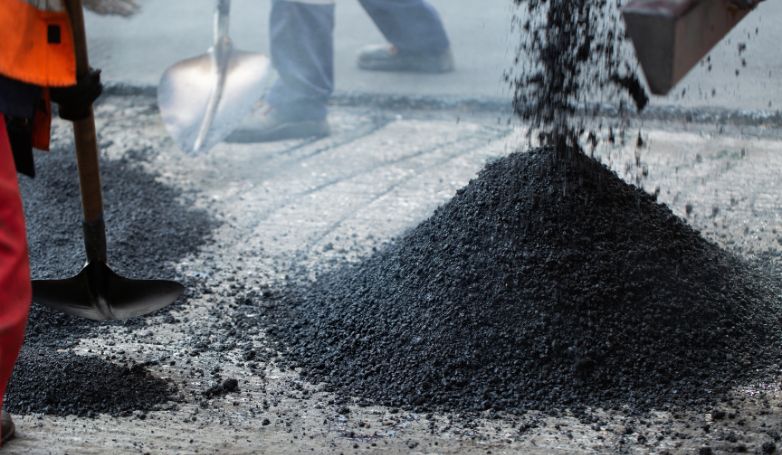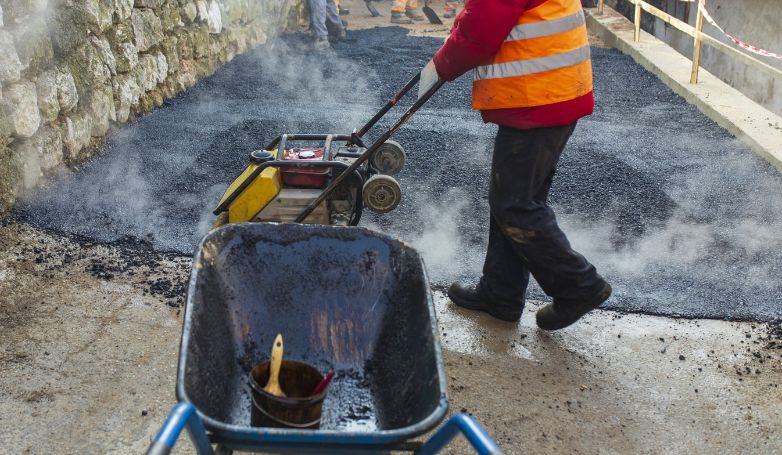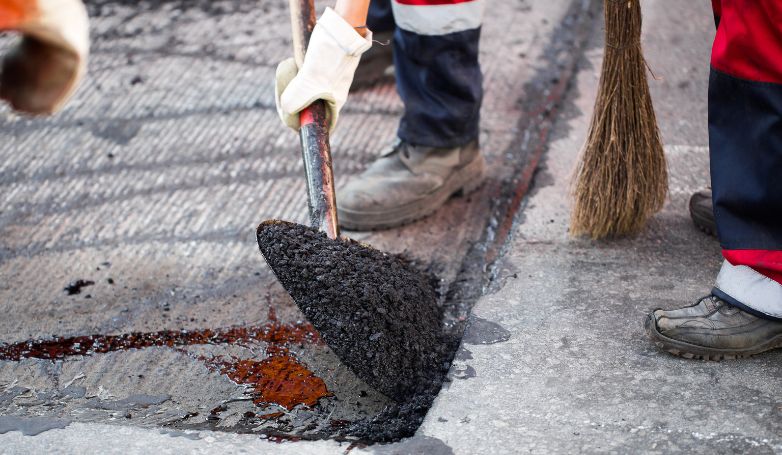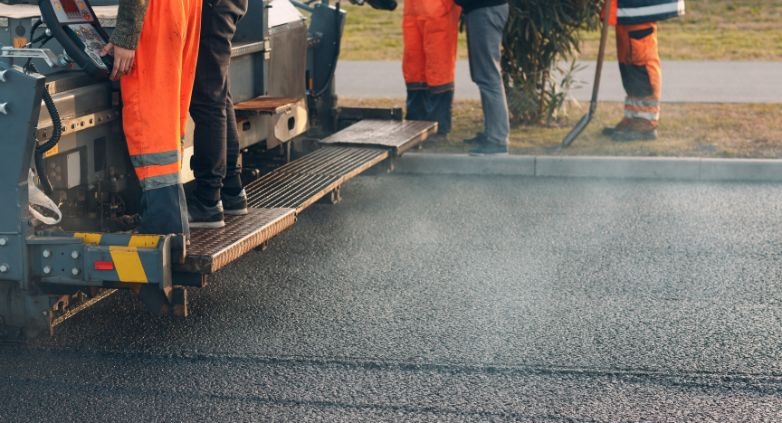Asphalt Paving – 8 Strategic Steps for a Smooth Base
Asphalt paving offers a robust solution for creating durable surfaces, blending practicality with aesthetic appeal for roads, driveways, and parking areas.
Understanding the intricacies of asphalt paving is crucial for anyone considering this versatile material for their next project. To ensure your project stands the test of time and use, follow these essential steps:
- Clearing and Grading
- Sub-base and Base Preparation
- Asphalt Mix Design
- Paving Process
- Quality Control and Inspection
- Joint Construction
- Surface Finishing
- Cleanup and Debris Removal
This approach addresses every decision’s impact on the pavement’s longevity and performance, from selecting the right mix to the final maintenance steps. Whether you’re a property owner or a professional in the industry, adhering to these steps ensures a successful asphalt paving project.
Dive deeper into the world of asphalt paving, where we explore each step in detail, ensuring you’re equipped for a successful project.
Understanding Asphalt

Asphalt, a petroleum-based material, is prized for its waterproofing and adhesive properties. It comprises a mixture of bitumen (asphalt cement) and aggregates (sand, gravel, and stones), creating a flexible and resilient paving material.
Different Types of Asphalt Used in Paving
There are various asphalt mixes, each tailored for specific conditions and uses. Hot mix asphalt (HMA) is commonly used for roadways and parking lots due to its durability. Cold mix asphalt, suitable for low-traffic areas or temporary repairs, and warm mix asphalt, a more environmentally friendly option, are also available.
Importance of Proper Material Selection
Selecting the appropriate asphalt mix is crucial for the pavement’s performance. Factors such as climate, traffic load, and the pavement’s intended use guide this selection, ensuring the pavement can withstand its operational demands.
8 Steps to Achieve a Perfect Asphalt Surface
Let’s delve into these essential steps that ensure the durability, functionality, and visual appeal of asphalt pavements.
1. Clearing and Grading

The initial step in achieving a flawless asphalt surface is the meticulous process of clearing and grading. This involves the removal of debris and vegetation, creating a clean slate for construction. Simultaneously, precise grading ensures proper water drainage, a crucial factor for the longevity and performance of the asphalt pavement. Attention to detail in this phase sets the foundation for subsequent steps, allowing for optimal results in the paving process.
2. Sub-base and Base Preparation
Following thorough clearing and grading, the focus shifts to sub-base and base preparation, where the emphasis lies in establishing a stable foundation. Utilizing high-quality aggregates and ensuring proper compaction of the sub-base materials are imperative to provide the necessary support for the asphalt surface. The uniformity and stability achieved during this phase play a critical role in the overall structural integrity of the pavement.
3. Asphalt Mix Design
Moving forward, the asphalt mix design phase demands precision in proportioning aggregates and selecting binders. This step is the key to formulating a mixture that balances durability and flexibility. Careful consideration is given to the role of aggregates in the mixture and the selection of an appropriate binder. Temperature control during the mixing process is also crucial, ensuring consistency in the mix and contributing to the quality of the final asphalt surface.
4. Paving Process

The actual paving process involves the use of suitable equipment and machinery, with a focus on proper calibration and maintenance to ensure optimal performance. Achieving the desired pavement thickness is paramount, as is ensuring adequate compaction for durability. This step requires a strategic approach to lay down the asphalt mixture evenly and efficiently, setting the stage for a robust and long-lasting surface.
5. Quality Control and Inspection
Quality control and inspection form a critical aspect of the asphalt paving process, involving rigorous measures to ensure the integrity of materials and mixtures. Implementing quality assurance measures and conducting regular tests at various stages of the process help identify and address any deviations promptly. Real-time monitoring of paving parameters ensures that the quality standards are met, contributing to the overall success of the project.
6. Joint Construction
Proper construction of joints is a pivotal step in preventing cracks in the asphalt surface. This phase emphasizes the importance of seamless joint construction, requiring techniques that ensure continuity and structural integrity. Additionally, timing and curing methods are carefully considered to optimize joint construction, contributing to the overall strength and durability of the asphalt pavement.
7. Surface Finishing

The surface finishing phase of asphalt paving is an art that involves achieving a smooth, aesthetically pleasing surface. Proper finishing techniques are essential for both functionality and visual appeal. Attention to detail is crucial in addressing surface irregularities, and the incorporation of textures enhances skid resistance for improved safety. Surface finishing adds the final touches to the asphalt pavement, elevating its overall quality.
8. Cleanup and Debris Removal
The final steps in achieving a perfect asphalt surface involve cleanup and debris removal. This phase focuses on clearing excess materials left after the paving process, contributing to a clean and polished appearance. Thorough cleanup ensures that the finished asphalt surface is free from any hindrances, allowing it to showcase its durability and visual appeal. The attention to detail in this concluding step reflects the commitment to excellence in the entire asphalt paving process.
Asphalt Paving Pros

Explore the following key attributes that contribute to the widespread use and popularity of asphalt in the construction industry.
Durability
Asphalt paving is renowned for its durability, offering robust resistance against heavy traffic and environmental stresses. Its ability to withstand wear and tear over time makes it a reliable choice for long-lasting road surfaces, reducing the frequency of repairs and ensuring extended service life.
Smooth Surface
This material provides a seamlessly smooth surface, enhancing driving comfort and safety. Its even texture minimizes friction, promoting smoother vehicle movement. The smoothness of asphalt surfaces is crucial for optimizing fuel efficiency and reducing wear and tear on vehicles, contributing to a more comfortable and efficient transportation experience.
Quick Installation
One of the significant advantages is its rapid installation process. Compared to alternative materials, asphalt can be laid quickly, minimizing disruptions to traffic or business activities. The reduced curing time allows for swift access to the paved area, making it an efficient choice for projects that require timely completion without compromising on quality.
Cost-Effective
Asphalt paving stands out for its cost-effectiveness, offering an economical solution for various construction projects. The initial installation costs are often lower than alternatives like concrete. Additionally, ongoing maintenance expenses are typically more affordable. The ability to conduct localized repairs further contributes to its cost-effectiveness, saving both time and resources over the pavement’s lifecycle.
Factors Influencing Asphalt Paving

These influential elements collectively shape the outcome of the paving endeavor, determining the asphalt’s durability, resilience, and overall performance.
Climate Considerations
The impact of climate on asphalt paving is profound, making it a key factor in the decision-making process. The dynamic nature of temperature fluctuations can lead to expansion and contraction in the asphalt, directly affecting its structural integrity. Selecting an asphalt mix tailored to the local climate becomes crucial, ensuring that the pavement can withstand the environmental challenges posed by varying weather conditions.
Traffic Load and Usage
Anticipating the volume and type of traffic a paved surface will encounter is fundamental in the asphalt paving equation. The wear and tear from different traffic loads demand a strategic approach to mix selection and pavement thickness. High-traffic areas, for instance, necessitate the use of denser and more durable asphalt mixes to withstand the continuous stress and prevent premature wear and deformation.
Soil Conditions and Preparation
This involves a comprehensive assessment of the soil’s bearing capacity, drainage capabilities, and overall stability. Enhancing these soil properties through meticulous preparation ensures a solid foundation for the asphalt, preventing potential issues like settling, shifting, or drainage problems. By addressing soil conditions upfront, the longevity and performance of the asphalt pavement are significantly enhanced.
Maintenance and Longevity of the Asphalt

Ensuring the prolonged life and resilience of asphalt pavements involves a comprehensive approach to maintenance. This strategy goes beyond reactive measures, emphasizing a proactive stance to prevent issues before they arise. By incorporating regular inspections, sealcoating, and resurfacing into a cohesive plan, the asphalt surface can endure the test of time, maintaining its functionality and appearance.
Regular Inspections and Repairs
The cornerstone of effective maintenance lies in regular inspections, acting as the first line of defense against wear, cracks, and other potential damages. Swift identification and immediate repair of these issues prevent further deterioration, preserving the structural integrity of the pavement and contributing to its long-term performance.
Sealcoating and Resurfacing
To safeguard against the elements, sealcoating becomes a shield, protecting the asphalt surface from water infiltration and UV damage. Complementing this, resurfacing acts as a rejuvenating process, replenishing the worn surface layer of pavements. Together, these measures not only extend the life of the asphalt but also enhance its overall resilience against environmental factors.
Strategies for Extending the Lifespan of Asphalt Pavement
The pursuit of longevity for asphalt pavement involves a strategic combination of routine maintenance and preventative measures. Implementing a proactive maintenance schedule, including regular inspections, sealcoating, and resurfacing, serves as a formidable strategy. These measures collectively contribute to extending the lifespan of the pavement, ensuring sustained performance and minimizing the need for extensive repairs or replacements.
Asphalt Paving Environmental Considerations

Addressing environmental concerns in asphalt paving involves a holistic approach, integrating sustainable practices, recycling efforts, and the incorporation of eco-friendly alternatives. By aligning with environmentally conscious strategies, the asphalt industry can contribute to a greener future, minimizing its ecological footprint.
Sustainable Practices in Asphalt Paving
Committing to sustainability in asphalt paving is synonymous with responsible industry practices. This encompasses the utilization of recycled materials, a concerted effort to reduce energy consumption during production, and the careful selection of eco-friendly asphalt mixes. Embracing these sustainable practices not only supports environmental well-being but also underscores the industry’s commitment to responsible resource management.
Recycling and Reusing Asphalt Materials
At the heart of sustainable asphalt practices lies the efficient recycling and reusing of asphalt materials. The utilization of reclaimed asphalt pavement (RAP) in new paving projects is a testament to the industry’s dedication to minimizing waste and resource consumption. This circular approach not only conserves valuable resources but also significantly reduces the environmental impact of asphalt production.
Eco-friendly Alternatives in Asphalt Mixtures
The integration of eco-friendly alternatives becomes paramount. This involves exploring innovative options, such as bio-based binders and incorporating recycled plastics into asphalt mixtures. By adopting these eco-friendly alternatives, the asphalt industry actively contributes to the reduction of environmental impact, fostering a sustainable balance between infrastructure development and ecological preservation.
Asphalt Paving Cost

By understanding how quality installation and ongoing maintenance can stretch the lifespan of your pavement, you’re essentially making an investment in durability that pays off over time, saving you from potential headaches and extra expenses down the road.
Initial Investment vs. Long-term Savings
Sure, the initial hit to your wallet for asphalt paving might raise some eyebrows, but think of it as a down payment on a future of savings. Proper installation and consistent maintenance are the unsung heroes here, working behind the scenes to extend the life of your pavement. It’s like investing in a vehicle with a stellar maintenance record – you’re in for a smooth ride that won’t burn a hole in your pocket with constant repairs.
Impact of Proper Paving on Property Value
A well-maintained asphalt pavement bumps up the overall value of your property. It’s not just about having a solid road; it’s about enhancing the entire vibe of your surroundings. The saying “first impressions matter” holds true here – a beautifully paved property can leave a lasting impression that translates into a worthwhile investment in the eyes of potential buyers or tenants.
Cost-effective Maintenance Strategies
Regular practices like crack filling and sealcoating aren’t just routine chores; they’re your pavement’s best friends. These simple yet effective strategies act as preventative measures, stopping potential issues in their tracks and sparing you from more extensive – and costly – repairs. It’s the equivalent of giving your pavement a health checkup, ensuring it stays in tip-top shape without draining your bank account.
FAQs about Asphalt Paving

Explore some common questions about asphalt paving here.
Can you asphalt over concrete?
Absolutely! Asphalt can be successfully applied over existing concrete surfaces, creating a fresh and durable top layer. This process, known as asphalt overlay, not only revitalizes the appearance but also provides a cost-effective solution for enhancing the structural integrity of the pavement. It’s a popular choice when looking to rejuvenate worn-out concrete areas without the need for extensive removal.
What’s under asphalt?
The foundation beneath asphalt is a crucial aspect of its performance. Typically, you’ll find multiple layers, starting with a sub-base composed of aggregates like crushed stone or gravel. Above this sits the base layer, often consisting of finer aggregates. These layers work in harmony to provide stability, drainage, and a robust support system for the asphalt surface, ensuring longevity and durability.
Is tarmac the same as asphalt?
While the terms “tarmac” and “asphalt” are often used interchangeably, they have subtle differences. “Tarmac” is a colloquial term derived from “tarmacadam,” a road surfacing material historically made with a tar binder. In modern usage, both tarmac and asphalt refer to road surfaces made with bitumen binders. However, asphalt is more commonly used today, made with bitumen mixed with aggregates like gravel or sand, offering improved flexibility and durability compared to traditional tarmacadam.
Conclusion
Proper asphalt paving is a multifaceted process that requires careful consideration of materials, techniques, and environmental impacts. By adhering to best practices in paving, maintenance, and sustainability, property owners and municipalities can ensure durable, cost-effective, and environmentally responsible asphalt pavements. This guide serves as a foundation for understanding the complexities of asphalt paving, emphasizing the importance of quality, maintenance, and sustainability in achieving long-lasting pavement solutions.


